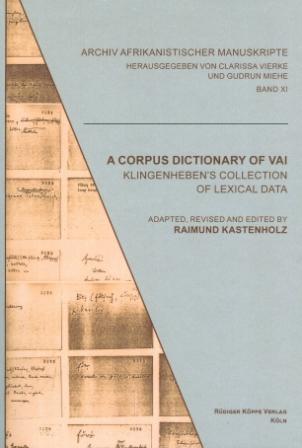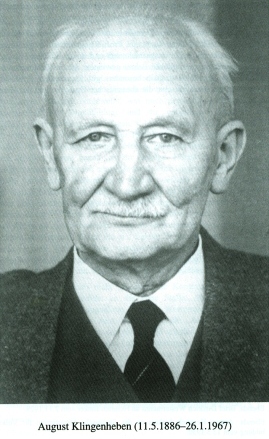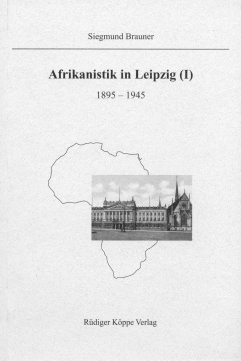


A Corpus Dictionary of Vai
Klingenheben’s Collection of Lexical Data
Author: Raimund Kastenholz. Series founded by: Gudrun Miehe, Hilke Meyer-Bahlburg. Series edited by: Clarissa Vierke, Gudrun Miehe.
Series: AAM Archiv afrikanistischer Manuskripte Volume 11
2019270 pp.
Text language(s): English
Format: 165 x 230 mm
540 g
Paperback
€ 69.80
Buy 'A Corpus Dictionary of Vai' as a downloadable PDF document directly from our online shop »
Order 'A Corpus Dictionary of Vai' as print edition »
The Vai language
Vai is a Mande language spoken by approximately 120,000 people, mainly located in Liberia (roughly 87% of the total number of speakers), and some in Sierra Leone. Together with Kɔnɔ (spoken in Sierra Leone), Vai forms a linguistically close-knit, albeit geographically discontiguous cluster. Within Mande, the Vai-Kɔnɔ Cluster belongs to the Central Branch of Western Mande (Kastenholz 1996: 70-71), next to Koranko and the Manding Dialect Cluster (this latter comprising varieties like Bamanan, Mandinka, Jula, Maninka, etc.).
The data collection background
August Klingenheben (1886-1967), from 1930 to 1936 director of the newly established Institute of African Languages at the University of Leipzig/Germany, was engaged in studying the Vai language of Liberia with varying intensity for about four decades of his life. He collected data on this language in 1927, 1951 and 1962 in Liberia (Jungraithmayr, Lexikon der Afrikanistik 1983: 130). More Vai data were gleaned at different periods of time at home, in Hamburg: From approximately 1924 to 1930, he worked with Momolu Massaquoi and his daughter Fatima, while Massaquoi was Consul to Hamburg, and had a teaching post at the University of that city.
In a second period (1953-1954), he worked with Zuke Kandakai, who had been awarded a grant for a stay in Hamburg (Kalthoff 2006: 48, 51; Everson et al. 2005: 1). Klingenheben unfortunately never came around to give shape to his intended major work on the Vai language. After his death, the collection of Vai lexical data from his legal estate has been transferred to and kept by the Staatsbibliothek Preußischer Kulturbesitz in Berlin. This is, literally, a shoebox collection (probably compiled between 1955 and 1956) of slips of paper (DIN standard A7), for the most part handwritten, some type-written, organised in two parts: Vai-German, consisting of roughly 6,360 slips, and German-Vai. The source material for the lexical data presented here is taken from the Vai-German part.
Following the link below you will find the text of the review by Alexandra Vydrina.
Under these links you will find further early publications of scholars of the Leipzig University and about Klingenheben’s linguistic research results, as well as descriptions of other West Mande languages and a systematic analysis of their history:
Accompanying material:
- Afrikanistik in Leipzig, 1895–1945
(ISBN 978-3-89645-309-9 ) - Klingenheben’s Law in Hausa
(ISBN 978-3-89645-521-5 ) - Tashelhiyt Berber Folktales from Tazerwalt (South Morocco)
(ISBN 978-3-89645-383-9 )
Cross-reference:
- Esquisse contrastive du kagoro (Manding)
(ISBN 978-3-89645-073-9 ) - Le malinké de Kita
(ISBN 978-3-89645-078-4 ) - Phonologie du jôwulu (« samogho »)
(ISBN 978-3-89645-075-3 ) - Sprachgeschichte im West-Mande
(ISBN 978-3-89645-071-5 )
Reviews
The publication of the Vai dictionary based on August Klingenheben’s collection and edited by Raimund Kastenholz is a very fortunate event for African studies. It finally makes the rich lexical database that was compiled by August Klingenheben (1886-1967) accessible. The thorough and consistent editorial work carried out by Kastenholz has made available the results of Klingenheben’s research and documentation project on Vai, which, as we learn from the introduction, spanned a period of over forty years. The dictionary will doubtlessly serve as a very useful tool for further research on this language.
Alexandra Vydrina in Mandenkan, 63/2020, 111-114
| « back | Print version | [top] |
 Books
Books Audio
Audio Biographies
Biographies Series
Series Festschrifts
Festschrifts Journals
Journals